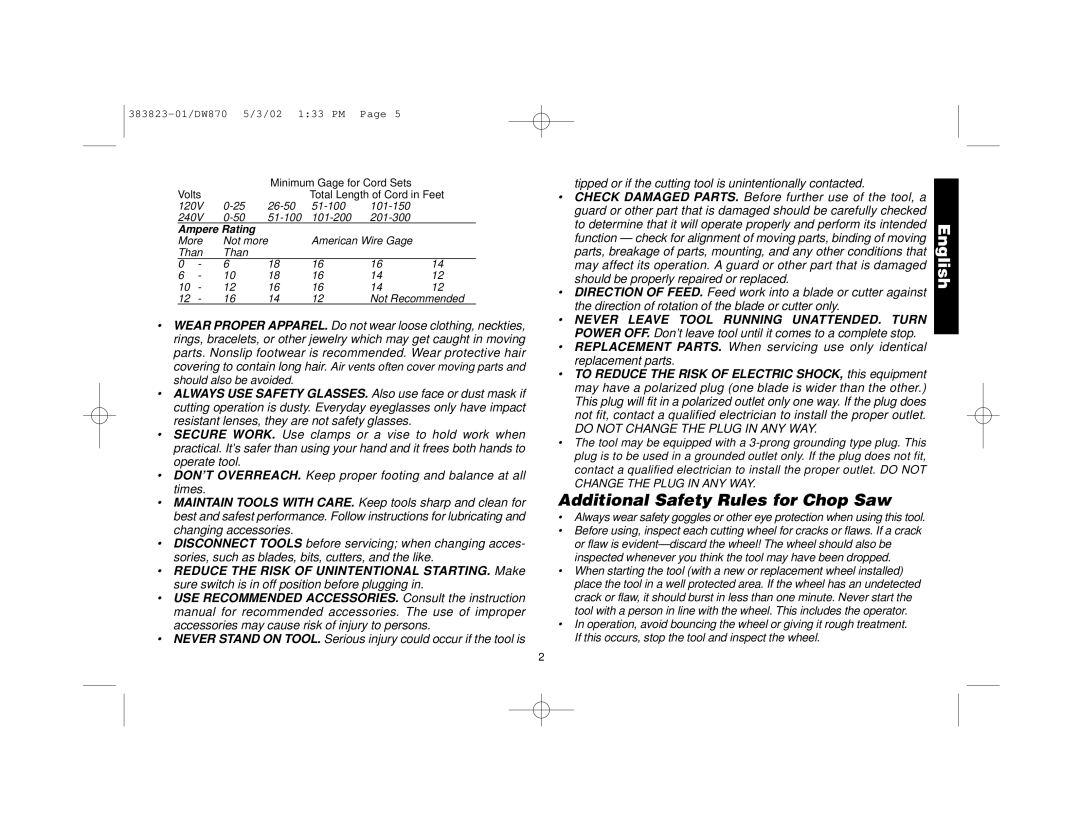
383823-01/DW870 5/3/02 1:33 PM Page 5
|
|
| Minimum Gage for Cord Sets |
| ||
Volts |
|
| Total Length of Cord in Feet | |||
120V |
| |||||
240V |
| |||||
Ampere Rating |
|
|
|
| ||
More | Not more | American Wire Gage |
| |||
Than | Than |
|
|
|
| |
0 | - | 6 | 18 | 16 | 16 | 14 |
6 | - | 10 | 18 | 16 | 14 | 12 |
10 | - | 12 | 16 | 16 | 14 | 12 |
12 | - | 16 | 14 | 12 | Not Recommended | |
•WEAR PROPER APPAREL. Do not wear loose clothing, neckties, rings, bracelets, or other jewelry which may get caught in moving parts. Nonslip footwear is recommended. Wear protective hair covering to contain long hair. Air vents often cover moving parts and should also be avoided.
•ALWAYS USE SAFETY GLASSES. Also use face or dust mask if cutting operation is dusty. Everyday eyeglasses only have impact resistant lenses, they are not safety glasses.
•SECURE WORK. Use clamps or a vise to hold work when practical. It’s safer than using your hand and it frees both hands to operate tool.
•DON’T OVERREACH. Keep proper footing and balance at all times.
•MAINTAIN TOOLS WITH CARE. Keep tools sharp and clean for best and safest performance. Follow instructions for lubricating and changing accessories.
•DISCONNECT TOOLS before servicing; when changing acces- sories, such as blades, bits, cutters, and the like.
•REDUCE THE RISK OF UNINTENTIONAL STARTING. Make sure switch is in off position before plugging in.
•USE RECOMMENDED ACCESSORIES. Consult the instruction manual for recommended accessories. The use of improper accessories may cause risk of injury to persons.
•NEVER STAND ON TOOL. Serious injury could occur if the tool is
2
tipped or if the cutting tool is unintentionally contacted.
•CHECK DAMAGED PARTS. Before further use of the tool, a guard or other part that is damaged should be carefully checked to determine that it will operate properly and perform its intended function — check for alignment of moving parts, binding of moving parts, breakage of parts, mounting, and any other conditions that may affect its operation. A guard or other part that is damaged should be properly repaired or replaced.
•DIRECTION OF FEED. Feed work into a blade or cutter against the direction of rotation of the blade or cutter only.
•NEVER LEAVE TOOL RUNNING UNATTENDED. TURN POWER OFF. Don’t leave tool until it comes to a complete stop.
•REPLACEMENT PARTS. When servicing use only identical replacement parts.
•TO REDUCE THE RISK OF ELECTRIC SHOCK, this equipment may have a polarized plug (one blade is wider than the other.) This plug will fit in a polarized outlet only one way. If the plug does not fit, contact a qualified electrician to install the proper outlet.
DO NOT CHANGE THE PLUG IN ANY WAY.
•The tool may be equipped with a
Additional Safety Rules for Chop Saw
•Always wear safety goggles or other eye protection when using this tool.
•Before using, inspect each cutting wheel for cracks or flaws. If a crack or flaw is
•When starting the tool (with a new or replacement wheel installed) place the tool in a well protected area. If the wheel has an undetected crack or flaw, it should burst in less than one minute. Never start the tool with a person in line with the wheel. This includes the operator.
•In operation, avoid bouncing the wheel or giving it rough treatment. If this occurs, stop the tool and inspect the wheel.
English
